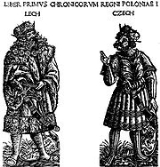
Lech, Czech and Rus
Encyclopedia
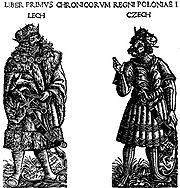
Poland
Poland , officially the Republic of Poland , is a country in Central Europe bordered by Germany to the west; the Czech Republic and Slovakia to the south; Ukraine, Belarus and Lithuania to the east; and the Baltic Sea and Kaliningrad Oblast, a Russian exclave, to the north...
(also known as Lechia
Lechia
Lechia is the historical and/or alternative name of Poland., stemming from the word Lech . It is still present in several European languages and some languages of Central Asia and the Middle East:...
), Bohemia
Bohemia
Bohemia is a historical region in central Europe, occupying the western two-thirds of the traditional Czech Lands. It is located in the contemporary Czech Republic with its capital in Prague...
, and Ruthenia
Ruthenia
Ruthenia is the Latin word used onwards from the 13th century, describing lands of the Ancient Rus in European manuscripts. Its geographic and culturo-ethnic name at that time was applied to the parts of Eastern Europe. Essentially, the word is a false Latin rendering of the ancient place name Rus...
(Rus', whose successor states are now Russia
Russia
Russia or , officially known as both Russia and the Russian Federation , is a country in northern Eurasia. It is a federal semi-presidential republic, comprising 83 federal subjects...
, Belarus
Belarus
Belarus , officially the Republic of Belarus, is a landlocked country in Eastern Europe, bordered clockwise by Russia to the northeast, Ukraine to the south, Poland to the west, and Lithuania and Latvia to the northwest. Its capital is Minsk; other major cities include Brest, Grodno , Gomel ,...
and Ukraine
Ukraine
Ukraine is a country in Eastern Europe. It has an area of 603,628 km², making it the second largest contiguous country on the European continent, after Russia...
). There are multiple versions of the legend, including several regional variants that mention only one or two of the brothers.
Variants of the legend
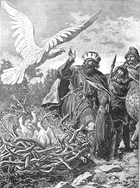
Ríp Mountain
Říp mountain is a 459 m solitary hill rising up from the central Bohemian flatland where, according to legend, the first Czechs settled. Říp is located 25 km south-east of Litoměřice, Czech Republic....
rising up from the Bohemian hilly countryside, while Lech traveled north. There, while hunting, he followed his arrow and suddenly found himself face-to-face with a fierce, white eagle guarding its nest from intruders. Seeing the eagle against the red of the setting sun, Lech took this sight as a good omen and decided to settle there. He named his settlement
Gord (Slavic settlement)
Gord is a medieval Slavic fortified settlement. This Proto-Slavic word for town or city, later differentiated into grad , gard, gorod , etc. The ancient peoples were known for building wooden fortified settlements...
Gniezno
Gniezno
Gniezno is a city in central-western Poland, some 50 km east of Poznań, inhabited by about 70,000 people. One of the Piasts' chief cities, it was mentioned by 10th century A.D. sources as the capital of Piast Poland however the first capital of Piast realm was most likely Giecz built around...
(Polish
Polish language
Polish is a language of the Lechitic subgroup of West Slavic languages, used throughout Poland and by Polish minorities in other countries...
gniazdo - 'nest') in commemoration and adopted the White Eagle
Coat of arms of Poland
The White Eagle is the national coat of arms of Poland. It is a stylized white eagle with a golden beak and talons, and wearing a golden crown, in a red shield.- Legal basis :...
as his coat-of-arms. The white eagle remains a symbol of Poland to this day, and the color of the eagle and the color of the setting sun are depicted in Poland's flag.
Other variations of Lech's name include: Lechus, Lachus, Lestus and Leszek. Czech, or Praotec Čech also comes under the Latin
Latin
Latin is an Italic language originally spoken in Latium and Ancient Rome. It, along with most European languages, is a descendant of the ancient Proto-Indo-European language. Although it is considered a dead language, a number of scholars and members of the Christian clergy speak it fluently, and...
name Bohemus or German
German language
German is a West Germanic language, related to and classified alongside English and Dutch. With an estimated 90 – 98 million native speakers, German is one of the world's major languages and is the most widely-spoken first language in the European Union....
Böhm, for the name is based on a pre-Slavic Celtic designation (Celtic tribe Boii, Latin form Boiohaemum that was used for Czech lands).
A variant of this legend, involving only two brothers, is also known in the Czech Republic
Czech Republic
The Czech Republic is a landlocked country in Central Europe. The country is bordered by Poland to the northeast, Slovakia to the east, Austria to the south, and Germany to the west and northwest....
. As described by Alois Jirásek
Alois Jirásek
Alois Jirásek was a Czech writer, author of historical novels and plays. Jirásek was a secondary-school teacher until his retirement in 1909. He wrote a series of historical novels imbued with faith in his nation and in progress toward freedom and justice...
in Staré pověsti české, two brothers came to Central Europe from the east: Čech and Lech. As in the Polish version, Čech is identified as the founder of the Czech nation (Češi pl.) and Lech as the founder of the Polish nation. Čech had to climb up the mountain Říp
RIP
R.I.P. is an abbreviation for rest in peace .R.I.P. or RIP may also refer to:-Biology:*Regulated intramembrane proteolysis, a biochemical process which regulates a semipermeable membrane...
, look to the landscape and settled with a tribe in the area, whereas Lech continued to the lowlands of the north.
A similar legend (with partly changed names) was also registered in folk tales at two separated locations in Croatia
Croatia
Croatia , officially the Republic of Croatia , is a unitary democratic parliamentary republic in Europe at the crossroads of the Mitteleuropa, the Balkans, and the Mediterranean. Its capital and largest city is Zagreb. The country is divided into 20 counties and the city of Zagreb. Croatia covers ...
: in the Kajkavian dialect
Kajkavian dialect
The Kajkavian dialect is one of the three main dialects of Croatian. It has low mutual intelligibility with the other two dialects, Štokavian and Čakavian. All three are named after their word for "what?", which in Kajkavian is kaj....
of Krapina in Zagorje
Zagorje
Hrvatsko Zagorje is a region in northern Croatia.Zagorje may also refer to:*Zagorje ob Savi, a town and a municipality in Slovenia*NK Zagorje, a Slovenian football club-See also:...
(northern Croatia) and in the Chakavian dialect
Chakavian dialect
Chakavian or Čakavian is a dialect of the Croatian language. The name stems from the word for "what?", which is "ča" in Čakavian...
of Poljica on the Adriatic Sea
Adriatic Sea
The Adriatic Sea is a body of water separating the Italian Peninsula from the Balkan peninsula, and the system of the Apennine Mountains from that of the Dinaric Alps and adjacent ranges...
(central Dalmatia
Dalmatia
Dalmatia is a historical region on the eastern coast of the Adriatic Sea. It stretches from the island of Rab in the northwest to the Bay of Kotor in the southeast. The hinterland, the Dalmatian Zagora, ranges from fifty kilometers in width in the north to just a few kilometers in the south....
). The Croatian variant was described and analysed in detail by S. Sakač in 1940.
Legend versus reality
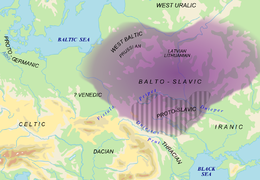
Poznan
Poznań is a city on the Warta river in west-central Poland, with a population of 556,022 in June 2009. It is among the oldest cities in Poland, and was one of the most important centres in the early Polish state, whose first rulers were buried at Poznań's cathedral. It is sometimes claimed to be...
. In Bohemian chronicles, Čech appears on his own or with Lech only; he is first mentioned as Bohemus in Cosmas
Cosmas of Prague
Cosmas of Prague was a Bohemian priest, writer and historian born in a noble family in Bohemia. Between 1075 and 1081, he studied in Liège. After his return to Bohemia, he became a priest and married Božetěcha, with whom he probably had a son. In 1086 Cosmas was appointed prebendary of Prague, a...
' chronicle (1125).
The legend suggests the common ancestry of the Poles
Poles
thumb|right|180px|The state flag of [[Poland]] as used by Polish government and diplomatic authoritiesThe Polish people, or Poles , are a nation indigenous to Poland. They are united by the Polish language, which belongs to the historical Lechitic subgroup of West Slavic languages of Central Europe...
, the Czechs and the Ruthenians
Ruthenians
The name Ruthenian |Rus']]) is a culturally loaded term and has different meanings according to the context in which it is used. Initially, it was the ethnonym used for the East Slavic peoples who lived in Rus'. Later it was used predominantly for Ukrainians...
(Russians
Russians
The Russian people are an East Slavic ethnic group native to Russia, speaking the Russian language and primarily living in Russia and neighboring countries....
, Ukrainians
Ukrainians
Ukrainians are an East Slavic ethnic group native to Ukraine, which is the sixth-largest nation in Europe. The Constitution of Ukraine applies the term 'Ukrainians' to all its citizens...
and Belarusians
Belarusians
Belarusians ; are an East Slavic ethnic group who populate the majority of the Republic of Belarus. Introduced to the world as a new state in the early 1990s, the Republic of Belarus brought with it the notion of a re-emerging Belarusian ethnicity, drawn upon the lines of the Old Belarusian...
) and illustrates the fact that as early as the 13th century, at least three different Slavic peoples were aware of being ethnically and linguistically interrelated, and, indeed, derived from a common root stock.
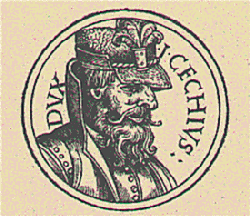
Slavic peoples
The Slavic people are an Indo-European panethnicity living in Eastern Europe, Southeast Europe, North Asia and Central Asia. The term Slavic represents a broad ethno-linguistic group of people, who speak languages belonging to the Slavic language family and share, to varying degrees, certain...
in eastern Europe. This area overlapped the region presumed by mainstream scholarship to be the Proto-Indo-European
Proto-Indo-Europeans
The Proto-Indo-Europeans were the speakers of the Proto-Indo-European language , a reconstructed prehistoric language of Eurasia.Knowledge of them comes chiefly from the linguistic reconstruction, along with material evidence from archaeology and archaeogenetics...
homeland in the general region of the Pontic-Caspian steppe. In the framework of the Kurgan hypothesis
Kurgan hypothesis
The Kurgan hypothesis is one of the proposals about early Indo-European origins, which postulates that the people of an archaeological "Kurgan culture" in the Pontic steppe were the most likely speakers of the Proto-Indo-European language...
, "the Indo-Europeans who remained after the migrations became speakers of Balto-Slavic".
The legend also attempts to explain the etymology of these people's ethnonym
Ethnonym
An ethnonym is the name applied to a given ethnic group. Ethnonyms can be divided into two categories: exonyms and autonyms or endonyms .As an example, the ethnonym for...
s: Lechia
Lechia
Lechia is the historical and/or alternative name of Poland., stemming from the word Lech . It is still present in several European languages and some languages of Central Asia and the Middle East:...
(another name for Poland), the Czech lands
Czech lands
Czech lands is an auxiliary term used mainly to describe the combination of Bohemia, Moravia and Czech Silesia. Today, those three historic provinces compose the Czech Republic. The Czech lands had been settled by the Celts , then later by various Germanic tribes until the beginning of 7th...
(including Bohemia, Moravia
Moravia
Moravia is a historical region in Central Europe in the east of the Czech Republic, and one of the former Czech lands, together with Bohemia and Silesia. It takes its name from the Morava River which rises in the northwest of the region...
, and Silesia
Silesia
Silesia is a historical region of Central Europe located mostly in Poland, with smaller parts also in the Czech Republic, and Germany.Silesia is rich in mineral and natural resources, and includes several important industrial areas. Silesia's largest city and historical capital is Wrocław...
), and Ruś
Rus
Ruś may refer to the following places:*Ruś, Podlaskie Voivodeship, a village in Łomża County, north-eastern Poland*Ruś, Olsztyn County, a village in Warmian-Masurian Voivodeship, northern Poland...
(Ruthenia). In fact, the term "Lechia" derives from the tribe of Lędzianie.
A prominent Renaissance Polish man of letters, Jan Kochanowski
Jan Kochanowski
Jan Kochanowski was a Polish Renaissance poet who established poetic patterns that would become integral to Polish literary language.He is commonly regarded as the greatest Polish poet before Adam Mickiewicz, and the greatest Slavic poet, prior to the 19th century.-Life:Kochanowski was born at...
, in his essay on the origin of the Slavs, makes no mention of the third "brother", Rus. Moreover, he dismisses the legend entirely, stating that "no historian who has taken up the subject of the Slavic nation [...] mentions any of those two Slavic leaders, Lech and Czech". He goes on to assume that "Czechy" and "Lachy" are quite probably the original names for the two nations, although he does not dismiss the possibility that there might have been a great leader by the name Lech whose name replaced the original and later forgotten name for the Polish nation.
Oaks of Rogalin
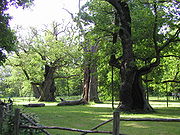
Oak
An oak is a tree or shrub in the genus Quercus , of which about 600 species exist. "Oak" may also appear in the names of species in related genera, notably Lithocarpus...
s in the garden adjacent to the 18th century palace in Rogalin
Rogalin
Rogalin is a village in western Poland, situated on the Warta river. It lies approximately east of the town of Mosina, and south of the city of Poznań....
, Greater Poland
Greater Poland
Greater Poland or Great Poland, often known by its Polish name Wielkopolska is a historical region of west-central Poland. Its chief city is Poznań.The boundaries of Greater Poland have varied somewhat throughout history...
. Each of them is several hundred years old. They vary between 23 and 30 feet in circumference. They've been declared natural landmarks and placed under protection.

